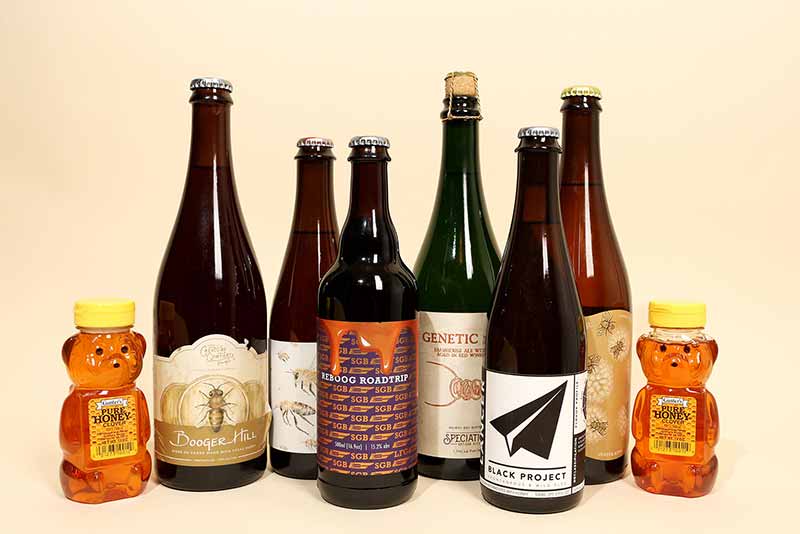
We’ve created some top guides on how brewers can brew with adjuncts, such as chocolate and fruit puree. When used appropriately, adding honey to beer is another nuanced product that can enhance aroma and flavor.
We chatted with Jester King Brewery and Off Color Brewing, who both make excellent honey beers, to learn about the best type of honey to use, where to add it in the brewing process, and the best ways to generate a dynamic honey beer that booms with aromatics and flavor.
(Above photography courtesy of John A. Paradiso | Hop Culture)
What We’ll Cover in This Piece:
Affordable, Industry-Leading Brewery Software
What the Experts Hope to Achieve by Adding Honey to Beer

Photography courtesy of @sapwoodcellars
Off Color Co-Founder John Laffler says it’s all about achieving both flavor and aroma when incorporating the ingredient into their beers.
“Honey itself is ninety-eight percent sugar, so it ferments out almost completely,” Laffler says. “If you are looking for sweetness, you need to pasteurize it.”
Jester King Brewer Michael Calle says they, too, look to generate mainly flavor and aroma. With a honey beer, the aim is to give the people what you’re telling them is in the beer.
“[The goal is] not to be subtle with the honey,” Calle says. “A lot of [brewers] lean toward [the motto] ‘better safe than sorry.’ You don’t want to disappoint customers.”
What Is the Best Type of Honey to Use in the Brewing Process?

Photography courtesy of John A. Paradiso | Hop Culture
The options at your discretion include honey malts, crystalized honey, and raw honey. While the first two ingredients work, nothing can replace the authenticity of actual honey.
“I can’t knock the malts. It can add something, but we don’t really lean toward malts,” Calle says. “If you look at one of our grain bills, it’s rather simple. We let the raw honey be the star.”
Jester King Brewer Josh Amos says that a honey beer is similar to a SMaSH beer.
“You don’t want to confuse anything. It’s like a SMaSH, when you want to highlight a mash or hop,” Amos says. “When we use honey, we want to let that shine … and we use quite a bit of it.”
Calle says that Jester King uses raw honey, and they did several bench trials and tastings from various brands before determining which company they wanted to use at Jester King for their mixed-culture honey beer.
“We source stuff as close to us as possible,” he says. “A lot of the time, the honey was different [from batch to batch]. I think we embrace the slight differences in the flavor of the [different] honey, considering it’s a mixed-culture beer.”
Laffler says Off Color also uses natural honey for their beers.
“We use raw, unpasteurized honey,” says Laffler, adding they try to buy locally when possible. “Honey sources have different flavors and profiles. You have to be careful about the apiary. … When you purchase honey, a lot of times, it will say something like ‘grapefruit honey,’ but if it’s grown in a non-grapefruit region, you should be suspicious. For us, that’s important.”
Laffler says they buy wildflower or clover honey—the easier-to-find kinds of honey—in bulk for the flavor element. They then get smaller portions of specialty honey for their “finishing honey,” seeking aromas to impart in the finished beer.
When Do You Add Honey in the Brewing Process?

Photography courtesy of Mae Mu | Unsplash
“The earlier you add it, the less you’ll get from it,” Laffler says. “The brewhouse will smell nice, but you won’t get a lot out of it.”
The initial injection of honey goes into the whirlpool. That’s when Off Color uses the bulk of the wildflower or clover honey.
“We’re looking to pasteurize it and send it through the system,” says Laffler, noting they also add a proper amount of brewer’s yeast.
The other specialty honey is used as a finishing element in late- or post-fermentation to get an aroma blown off during fermentation.
“The tank is capped or bunged to keep aroma in there,” Laffler says.
According to Laffler, Off Color has experimented with using honey in one other phase.
“We add honey during bottling as part of the bottle-conditioning,” he says. “We put it in hot water, around 99.9 degrees Celsius, and let it sit for fifteen minutes to pasteurize it and then put it in the bottle.”
He adds, “It’s the best way to maintain the aroma. It uses a much smaller amount and maximizes your value.”
Calle and Amos say that the Jester King recipe is longstanding, and they have never tried to tweak it—it works.
“We took that and built on that,” Calle says. “We stuck with the whirlpool addition.”
Amos says they have experimented with using honey for other beers, including attempting a Bochet-inspired beer where they boiled the honey for eight hours. Typical Bochet meads boil upwards of twenty-four hours.
“We took honey and did an eight-hour boil and then added that to the whirlpool,” Amos explains.
Calle adds, “We boiled the honey to deepen that flavor. It was highly inspired by mead.”
Jester King has also attempted a hop-inspired honey beer (a collab with Other Half) and added honey into a coolship for a spontaneously fermented wheat ale.
“We added one hundred pounds of wildflower honey into the coolship,” Amos says, “and let it sit eight to ten hours to catch the microbes.”
Amos says working with the coolship is easy because it goes into the vessel hot, around 205 degrees Fahrenheit, and the honey integrates seamlessly. In their standard honey beer, they whirlpool in honey at around 216 degrees Fahrenheit but do primary and secondary fermentation additions at colder temperatures—68 degrees and 78 degrees, respectively.
“That makes it trickier because we need to be able to do a recirculation on the beer to get full integration,” Amos says. “In the past, we have opened up a tank to do a CIP, only to realize there was still a bit of non-integrated honey in the tank.”
The finished products for their coolship beer or others are subtle, especially with the coolship as the beer goes into barrels and contends with those elements.
“I find that as we age the beer, the honey character mellows, integrates, and fades a bit over time,” Amos says. “With a typical stainless conical fermentation, the honey tends to present itself more.”
How Much Honey Should You Use?

Photography courtesy of Arwin Neil Baichoo | Unsplash
Calle admits there is no set amount for adding honey at Jester King.
“Undershooting is better,” Calle says. “We can add more if it’s too subtle.”
Jester King uses around 130 pounds to 150 pounds of honey in the whirlpool and another 50 pounds in secondary fermentation in a 300barrel batch of beer.
“It’s all just feel, really,” Calle says of how they got to the number. “It’s just trial and error.”
Amos and Calle credit the previous brewers at Jester King for nailing the amount.
“The honey additions have not changed a whole lot,” Amos says. “We think they are perfect and on point for what we’re looking for.”
Calle adds, “A lot of this is crediting past brewers, and we tweak to our liking. We stick to the same poundage but add it at a different time.”
Laffler says how much to use is entirely experimental. The honey breakdown is part of the whirlpool before fermentation and the post-fermentation addition for aroma.
“We don’t want to go over twenty percent non-malt-based sugars due to fermentable sugars,” Laffler says. “Even at fifteen percent, we need [to add] yeast nutrient.”
Laffler adds, “The finishing honey will be more like two percent with the same pasteurizing process.”
Despite that, Laffler says it’s hard to argue that more is not good from a flavor perspective.
“Make sure you have enough yeast nutrient is what to watch out for,” Laffler reiterates. “If yeast gets stressed out, a whole bunch of bad things can happen.”
Which Beer Style Best Showcases Honey?

Photography courtesy of Morgan Territory Brewing
Laffler says their Biere de Miel, or honey beer, is a Belgian-style saison. However, he says there are truly no limits when adding honey to different beer styles.
“People have added it to any style you can think of,” Laffler says.
The other styles, though, outside of Biere de Miel, like adding it to a lager, “is just some marketing department BS,” he adds.
Calle says honey will present well in two types of beer.
“My first go-to is mixed-culture because of the complexity,” Calle says. “Give it time, and the honey will come in tune with lacto and Brettanomyces.”
He adds, “Honey can also present pretty well in a pilsner if you add enough and pasteurize it.”
Laffler, Amos, and Calle point towards the National Honey Board as an amazing reference for brewers looking to learn how to use honey in beer and which styles to highlight it.
“They have a honey locator, which is really helpful,” Laffler says. “For instance, if you are looking for blackberry honey in Oregon, it’ll find it for you.”
Two Great Examples of Honey in Beer

Photography courtesy of Jester King Brewery
Ellie is Off Color’s honey beer. The 7.5% ABV beer has 15 IBUs. The Untappd page describes the beer as dry, with notes of honey on the finish complementing spice oils reminiscent of gin and floral and perfume aromas.
“It’s a cocktail-inspired beer,” Laffler says. “I’m a big fan of gin. We wanted to emulate a honey, lemon, gin cocktail.”
He adds, “We used orange blossom honey as the bulk honey and lemon blossom honey as the finishing.”
Jester King’s Biere de Miel is 5.8% ABV and has 49 IBUs. The beer has Texas wildflower honey added on the hot side and more honey thrown in at the end of fermentation.
“It’s simple until the honey comes in, and to me, that’s all the flavor right there,” Calle says. “The most important ingredient with that beer is time … it’s what makes our honey beer different.”



